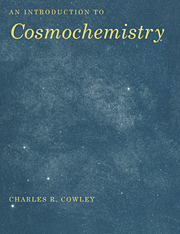Book contents
- Frontmatter
- Contents
- Foreword
- 1 Overview
- 2 Minerals: An Introduction to the Nomenclature and Chemistry
- 3 A Brief Introduction to Petrology
- 4 A Résumé of Thermodynamics and Statistical Mechanics
- 5 Condensation Sequences and the Geochemical Classification of the Elements
- 6 The Theory of the Bulk Composition of the Planets
- 7 Meteorites and the Standard Abundance Distribution (SAD)
- 8 An Introduction to Isotope Geology with an Emphasis on Meteorites
- 9 Some Concepts from Nuclear Physics
- 10 Energy Generation in Stars and Nucleosynthesis
- 11 Atomic and Molecular Spectra
- 12 The Analysis of Stellar Spectra
- 13 The Chemistry of Stars and Stellar Systems
- 14 Cold, Non-stellar Material in Galaxies
- 15 Emission-Line Regions and their Chemical Abundances
- 16 Abundances of the Elements in Galaxies
- Appendix
- References
- Index
1 - Overview
Published online by Cambridge University Press: 05 June 2012
- Frontmatter
- Contents
- Foreword
- 1 Overview
- 2 Minerals: An Introduction to the Nomenclature and Chemistry
- 3 A Brief Introduction to Petrology
- 4 A Résumé of Thermodynamics and Statistical Mechanics
- 5 Condensation Sequences and the Geochemical Classification of the Elements
- 6 The Theory of the Bulk Composition of the Planets
- 7 Meteorites and the Standard Abundance Distribution (SAD)
- 8 An Introduction to Isotope Geology with an Emphasis on Meteorites
- 9 Some Concepts from Nuclear Physics
- 10 Energy Generation in Stars and Nucleosynthesis
- 11 Atomic and Molecular Spectra
- 12 The Analysis of Stellar Spectra
- 13 The Chemistry of Stars and Stellar Systems
- 14 Cold, Non-stellar Material in Galaxies
- 15 Emission-Line Regions and their Chemical Abundances
- 16 Abundances of the Elements in Galaxies
- Appendix
- References
- Index
Summary
The Scope of Cosmochemistry
The cosmochemist has two basic tasks. The first is to determine the chemical composition of matter in the material universe. The form of this matter ranges from such mundane materials as terrestrial rocks to distant galaxies. The second task is to understand the reasons for the compositions that are found. While the first of these tasks is basically a matter of analytical chemistry, the second has important evolutionary aspects.
From a logical and historical point of view, cosmochemistry is an extension of the well-established discipline of geochemistry. Victor Goldschmidt, one of the pioneers of modern geochemistry, had a keen interest in abundances of the chemical elements in meteorites and the sun and stars. Goldschmidt (1937) was an early compiler of what became known as the cosmic abundances, in which the analyses of extraterrestrial sources played important roles.
The logical complement to the term geochemistry, in the astronomical domain, would be astrochemistry. This word is frequently in the literature, but typically with a more restricted meaning, such as the formation of molecules in cool interstellar clouds. Solar system astronomers have used terms such as planetary geology or lunar geochemistry rather than astrogeology or astrochemistry.
For many years, astronomers thought of cosmochemistry primarily in terms of the nuclear history of matter, and the search for a standard abundance distribution (SAD). The modern aspects of this work began with Goldschmidt, and were continued by Hans Suess and H. C. Urey (1956).
- Type
- Chapter
- Information
- An Introduction to Cosmochemistry , pp. 1 - 8Publisher: Cambridge University PressPrint publication year: 1995

